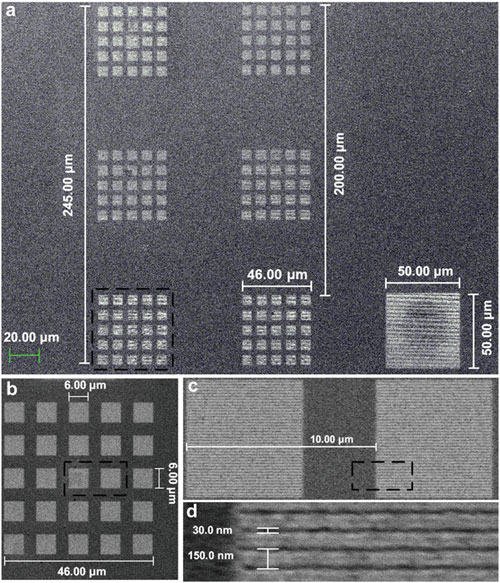| Posted: Jun 13, 2017 | |
A nanogroove metasurface for submolecular detection(Nanowerk News) An international team of researchers has designed a hyperbolic metasurface with metallic nanogroove structure. |
|
| As the team reports in Small ("Multifunctional Hyperbolic Nanogroove Metasurface for Submolecular Detection"), this nanogroove metasurface provides multiple functions: | |
|
|
|
 |
|
| SEM images of the nanogroove hyperbolic metasurface. a) The distribution of the six patches of nanogroove arrays and the coupling grating structure. b) The enlarged view of one patch of nanogroove arrays. Each patch consists of 5 × 5 groove nanostructures. c) The enlarged view of the two adjacent groove nanostructures. d) The detailed view of the groove nanostructure with the width of 30 nm and the periodicity of 150 nm. (© Wiley-VCH Verlag) (click on image to enlarge) | |
| The authors note that their designed nanogroove hyperbolic metasurface presents strong light–matter interactions that can achieve submolecule detection with ultrahigh sensitivity. The propagations of the surface plasmon waves can be controlled and manipulated by the groove nanostructures. | |
| The electric field on the sensing surface is significantly enhanced due to the highly confined surface plasmons in the plane and the increased local density of states on the groove ridge. | |
| The perfect absorption can be achieved due to the constructive interference and increased damping constant of the hyperbolic metasurface. | |
| By tuning the optical frequency, surface plasmon waves can be tightly confined and propagating in a diffraction-free direction induced by the zero refractive index. | |
| "These significant performances of the nanogroove metasurface would allow the creation of on-chip multifunctional photonic and optoelectronic devices for biosensing, imaging, and quantum communication," the researchers conclude. |
 By
Michael
Berger
– Michael is author of three books by the Royal Society of Chemistry:
Nano-Society: Pushing the Boundaries of Technology,
Nanotechnology: The Future is Tiny, and
Nanoengineering: The Skills and Tools Making Technology Invisible
Copyright ©
Nanowerk LLC
By
Michael
Berger
– Michael is author of three books by the Royal Society of Chemistry:
Nano-Society: Pushing the Boundaries of Technology,
Nanotechnology: The Future is Tiny, and
Nanoengineering: The Skills and Tools Making Technology Invisible
Copyright ©
Nanowerk LLC
|
|
|
Subscribe to a free copy of one of our daily Nanowerk Newsletter Email Digests with a compilation of all of the day's news. |
